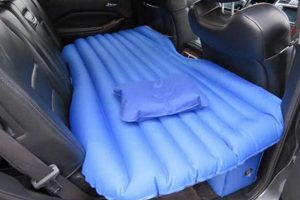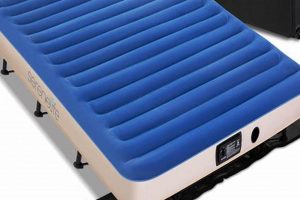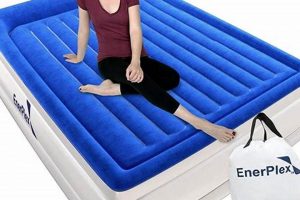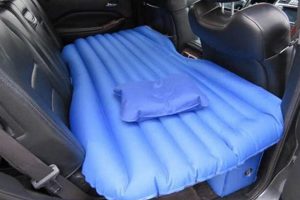Locating the source of escaping air from an inflatable sleeping surface involves a systematic process of inspection and detection. This process relies on observing physical cues and employing sensory techniques to identify the precise location where air is being released. Pinpointing the origin of these leaks is crucial for effective repair and restoration of the inflatable’s functionality.
Identifying these faults in a timely manner is essential for maintaining the usability and extending the lifespan of the air mattress. A mattress that retains its inflation provides consistent support and comfort, contributing to a restful sleep experience. Understanding the methods for fault detection allows individuals to address issues promptly, preventing further damage and potential replacement costs. Historically, these techniques have evolved from simple auditory assessments to more sophisticated methods using soapy water and visual inspection.
The subsequent sections will detail specific methodologies for detecting these air escapes, including auditory examination, tactile investigation, soapy water application, and submersion testing. Each technique offers a unique approach to isolating the fault and preparing the mattress for repair.
Strategies for Identifying Air Leaks in Inflatable Mattresses
The effective detection of air leaks in inflatable mattresses necessitates a methodical approach. Employing the following strategies can facilitate accurate identification of the source of escaping air.
Tip 1: Auditory Assessment. Begin by inflating the mattress to its maximum capacity in a quiet environment. Carefully listen for hissing sounds, which may indicate the location of escaping air. Concentrate on seams, valves, and areas prone to wear.
Tip 2: Tactile Examination. Once inflated, pass a hand slowly over the surface of the mattress, feeling for escaping air currents. Pay particular attention to areas identified during the auditory assessment. Subtle drafts can pinpoint the location of a leak.
Tip 3: Soapy Water Application. Mix a solution of mild dish soap and water. Apply the solution liberally to suspected areas using a sponge or spray bottle. The formation of bubbles indicates the presence of escaping air.
Tip 4: Submersion Testing (Partial). If the leak remains elusive, consider partially submerging sections of the inflated mattress in water, such as a bathtub or large container. Observe for bubbles rising from the submerged area, indicating the location of escaping air.
Tip 5: Valve Inspection. The valve is a common source of air leaks. Inspect the valve for proper sealing and any signs of damage. Applying soapy water to the valve area can reveal subtle leaks.
Tip 6: Marking the Location. Once a leak is identified, clearly mark the spot with a permanent marker or piece of tape. This will facilitate accurate repair.
Tip 7: Gradual Approach. If the mattress is large, work methodically in sections. Fully inspect one area before moving to the next to avoid overlooking any potential leaks.
These strategies enhance the likelihood of successfully identifying the source of air loss, enabling appropriate repair measures and prolonging the lifespan of the inflatable mattress.
The next section will address common repair techniques for identified leaks.
1. Auditory Detection
Auditory detection represents a primary and often initial method in the process of determining the presence and location of an air leak in an inflatable mattress. The principle behind this method rests on the acoustic properties of escaping pressurized gas. When air escapes through a small opening, it generates an audible hissing sound. The intensity of this sound is directly proportional to the pressure differential and the size of the opening. Therefore, a larger leak or a mattress inflated to a higher pressure will typically produce a louder, more easily detectable sound.
The effectiveness of auditory detection is significantly influenced by the ambient noise level. A quiet environment is essential for discerning the subtle hissing sounds associated with small leaks. Real-world examples illustrate the challenges: attempting auditory detection in a room with running appliances or background conversation significantly reduces the method’s efficacy. In contrast, a quiet room, especially at night, allows even minor leaks to be identified. The practical significance of understanding this connection lies in the realization that careful attention to environmental conditions is crucial for successful leak detection.
In conclusion, auditory detection provides a valuable first step in locating air leaks, offering a non-invasive and readily accessible technique. However, its effectiveness is contingent upon minimizing background noise. While auditory detection may not pinpoint the exact location of a very small leak, it serves as an indicator of a problem, prompting the use of supplementary methods such as soapy water application or submersion testing. It represents a critical component within the broader strategy of maintaining and repairing air mattresses.
2. Visual Inspection
Visual inspection constitutes a fundamental step in identifying the source of air leakage in inflatable mattresses. This technique relies on the careful examination of the mattress surface for physical indicators that may signal a breach. These indicators can include, but are not limited to, punctures, tears, abrasions, and discolored areas, all of which potentially compromise the integrity of the air chamber. The efficacy of visual inspection is contingent upon adequate lighting and meticulous scrutiny, particularly along seams, around the valve, and in areas subjected to frequent stress or folding.
The importance of visual inspection within the process of isolating the origin of air leaks stems from its non-invasive nature and potential to quickly identify obvious damage. For instance, a large tear resulting from contact with a sharp object will be readily apparent through visual examination. Similarly, areas exhibiting excessive wear or discoloration may indicate weakened material susceptible to air leakage. Real-world application involves systematic scanning of the mattress, followed by closer examination of any anomalies detected. Without a thorough visual check, more subtle leaks may be overlooked, necessitating more involved detection methods.
In conclusion, visual inspection provides an essential first line of defense in localizing air leaks in mattresses. Its simplicity and accessibility make it a crucial component of a comprehensive detection strategy. While it may not reveal every leak, especially those that are microscopic in size, its potential to identify significant damage quickly saves time and resources. Therefore, a diligent visual sur
vey should always precede the implementation of other, more complex, leak detection methods.
3. Soapy Water
The application of soapy water serves as a critical method in locating escaping air from an inflatable mattress. This technique leverages the principle that when pressurized air exits through a small opening, it creates a disturbance within a liquid film. A solution of soapy water, applied to the surface of an inflated mattress, forms a thin film. Where air escapes, this film is disrupted, resulting in the formation of visible bubbles. The location of these bubbles directly indicates the source of the air leak.
The effectiveness of this approach depends on several factors. The solution must be sufficiently soapy to create a stable film. Excessive soap, however, can leave residue that is difficult to remove. The surface of the mattress should be clean and free of debris that could interfere with bubble formation. Real-world examples illustrate the utility of this method. When a slow leak is suspected but not readily apparent, spraying soapy water along seams and around the valve often reveals the exact point of air egress. This method is especially useful for locating pinhole leaks that are difficult to detect by sight or sound alone. The practical significance of understanding this process lies in its ability to pinpoint the source of leaks, enabling precise and efficient repair, thereby extending the lifespan of the mattress.
In summary, the application of soapy water represents a vital component in a comprehensive strategy. It provides a visual means of locating leaks that may be otherwise undetectable. While careful surface preparation and appropriate solution concentration are essential, this method remains a cost-effective and reliable technique for maintaining air mattresses. The formation of bubbles signifies air leaving from the leak, enabling for it to be patched.
4. Submersion Testing
Submersion testing represents an advanced technique employed when standard methods fail to pinpoint air leaks in inflatable mattresses. This method involves immersing portions of the inflated mattress in water to visually identify escaping air bubbles, offering a precise means of locating breaches that are otherwise difficult to detect.
- Complete Immersion Feasibility
Complete submersion of a large air mattress presents logistical challenges due to size and buoyancy. Typically, submersion is conducted section by section, focusing on suspect areas identified through prior auditory or soapy water tests. The feasibility of this approach hinges on the availability of a sufficiently large container, such as a bathtub or swimming pool. For instance, with a large inflatable mattress, achieving full submersion would be very challenging and dangerous.
- Bubble Identification
The core principle of submersion testing relies on the visual identification of air bubbles emanating from the mattress. When submerged, even a minute leak will produce a stream of bubbles as pressurized air escapes. Observing the origin of these bubbles provides a direct indication of the leak’s location. One can look out for even the smallest sign of bubbles and mark them out for patching the holes.
- Cleanliness Considerations
The water utilized for submersion testing must be clean and free of debris that could obscure bubble formation or introduce contaminants into the mattress material. Hard water may leave deposits on the mattress. Contaminants in the water pose a high risk and would require additional drying time and possible residue. Therefore, the use of filtered or distilled water is recommended to ensure optimal visibility and prevent potential damage.
- Post-Submersion Drying
Following submersion testing, complete and thorough drying of the mattress is essential to prevent mold growth or material degradation. Water trapped within the mattress’s internal structure can create a breeding ground for microorganisms, compromising its integrity and hygiene. Therefore, adequate drying time, coupled with the use of fans or dehumidifiers, is necessary to mitigate these risks. It is best to dry it out in the sunshine.
Submersion testing offers a reliable means of pinpointing otherwise elusive air leaks. While logistical considerations and potential complications necessitate careful execution, this method remains a valuable tool in the process and repair. By systematically submerging and drying, leak locations can be accurately marked, enabling efficient repair and restoration of the mattress’s functionality.
5. Valve Examination
Valve examination represents a critical step in the diagnostic process of determining air leakage in inflatable mattresses. The valve assembly, serving as the primary interface for inflation and deflation, is a common point of failure and, therefore, requires meticulous inspection.
- Valve Seat Integrity
The valve seat, the surface against which the valve seals, is susceptible to damage or debris accumulation. Even minute imperfections on this surface can prevent a complete seal, resulting in slow but persistent air leakage. Examination involves visually inspecting the seat for cracks, warps, or foreign particles. Real-world application involves cleaning the valve seat with a soft cloth and mild detergent to remove any obstructions.
- Valve Core Functionality
The valve core, typically a Schrader or similar type, controls the flow of air into and out of the mattress. Malfunctioning valve cores, characterized by weakened springs or damaged seals, are a frequent source of leakage. Inspection involves testing the core’s sealing ability by applying soapy water around the valve stem while the mattress is inflated. The presence of bubbles indicates a faulty core requiring replacement or tightening.
- Valve Housing Seal
The valve housing, the structure that encases the valve mechanism, is sealed to the mattress material. The integrity of this seal is paramount to preventing air escape. Examination entails inspecting the perimeter of the housing for signs of separation, adhesive failure, or physical damage. Applying pressure to the housing while listening for hissing sounds can reveal subtle leaks. Corrective measures include re-sealing the housing with appropriate adhesive or replacing the entire valve assembly.
- One-Way Valve Mechanism
Certain air mattress valves incorporate a one-way mechanism to prevent backflow during inflation. These mechanisms can become obstructed or damaged, leading to leakage. Examination involves testing the one-way function by attempting to deflate the mattress without actively depressing the valve core. If air escapes freely, the one-way mechanism is compromised and requires repair or replacement.
In summary, a thorough valve examination is indispensable in the efficient determination of air leakage. Addressing issues related to the valve seat, core functionality, housing seal, and one-way mechanism significantly improves the likelihood of isolating and rectifying the source of air loss, thus restoring and maintain op
timal inflation and use. It’s one of the most common causes for air leakage in an air mattress, so testing it is an important and vital part of finding the leak.
6. Seam Assessment
Seam assessment constitutes an integral component in the determination of air leaks in inflatable mattresses. The seams, representing the junctions where individual pieces of material are joined, are inherently vulnerable to stress and separation, making them a frequent point of failure. Identifying compromised seams is therefore crucial to the process of locating and repairing air leaks.
The connection between seam assessment and effective leak location is causal: weakened or separated seams directly result in air leakage. Visual inspection for separation, fraying, or adhesive failure is a primary step. Tactile examination, involving running a hand along the seam to feel for escaping air currents, provides further insight. Soapy water application, revealing bubbles at the seam line, confirms the presence and location of a leak. Real-life scenarios frequently involve leaks originating at the seams due to manufacturing defects, material degradation, or excessive stress from over-inflation or improper use. For example, a seam subjected to repeated folding may exhibit weakened adhesive, leading to gradual air loss. Identifying and addressing these seam-related leaks is essential for restoring the mattress’s ability to retain air.
In conclusion, thorough seam assessment is indispensable to the success of any diagnostic procedure aimed at localizing air leaks in an inflatable mattress. By systematically examining seams through visual, tactile, and soapy water methods, individuals can effectively identify and address seam-related breaches. The practical significance of this understanding lies in preventing further damage, preserving mattress functionality, and prolonging its lifespan. Therefore, including checking the seams in essential to how to find a leak in an air mattress.
7. Patch Identification
Patch Identification is the culminating step in the process of locating air leaks in an air mattress, directly following the successful execution of methods used to reveal the location of escaping air. It serves as the validation point, confirming that the identified area corresponds to an actual breach requiring repair. The purpose is to ensure that patching efforts are focused accurately, preventing wasted time and resources on non-leaking areas.
- Confirmation of Leak Source
Prior to applying a patch, definitive confirmation that the marked area is indeed the source of the leak is paramount. This involves re-examining the area using the method that initially revealed the leak, such as soapy water or submersion. For example, observing bubbles consistently emanating from the marked point when soapy water is reapplied reinforces the accurate leak location. If doubt persists, further investigation is needed.
- Extent of Damage Assessment
Patch Identification also involves evaluating the size and nature of the damage. A small pinhole requires a significantly smaller patch than a large tear. Furthermore, the patch material and adhesive must be appropriate for the mattress material and the nature of the damage. Real-world application entails matching patch size and adhesive strength to the identified leak, ensuring a durable and effective repair.
- Surface Preparation Verification
Proper adhesion of the patch requires a clean and dry surface. Patch Identification includes confirming that the area surrounding the leak has been adequately cleaned and prepared according to the patch manufacturer’s instructions. Failure to properly prepare the surface can result in patch failure and renewed leakage. For example, ensuring the area is free of oils or residues and is completely dry before patch application.
- Documentation for Future Reference
Patch Identification can also include documenting the location and nature of the leak for future reference. This information can be valuable if the mattress experiences further leaks, helping to identify patterns or weak points. Documentation may involve taking photographs or making notes regarding the type and location of the damage. Documenting issues for future reference helps to create a process of improvements.
In conclusion, Patch Identification is essential for ensuring the successful repair of air mattresses. By rigorously confirming the leak source, assessing the extent of damage, verifying surface preparation, and documenting the repair, effective and lasting repairs become far more probable. This careful approach enhances the overall lifespan of the mattress and minimizes recurring issues associated with air leaks, a vital component to the process.
Frequently Asked Questions
This section addresses common inquiries regarding the identification of air leaks in inflatable mattresses, providing detailed explanations and practical guidance.
Question 1: Why is pinpointing the source of escaping air important?
Identifying the precise location of an air leak is crucial for effective repair. Accurate identification prevents wasted effort on non-damaged areas and ensures that repair efforts are concentrated where they are most needed, maximizing the chances of a successful and lasting fix.
Question 2: What is the first step when attempting to locate escaping air?
The initial step is to fully inflate the mattress. This creates sufficient pressure to make air leaks more detectable. Following inflation, conduct a thorough visual inspection, looking for any obvious signs of damage or stress to the material.
Question 3: How does soapy water help in locating air leaks?
Soapy water, when applied to the surface of the inflated mattress, forms a thin film. At the point of air escape, this film is disrupted, and bubbles form. These bubbles directly indicate the location of the leak, even if it is too small to be seen or heard.
Question 4: What if the leak cannot be found using soapy water?
If soapy water proves ineffective, consider partial submersion of the mattress in water. Escaping air will manifest as a stream of bubbles emanating from the point of leakage. Ensure the water is clean to avoid obscuring the bubbles.
Question 5: Why is valve examination a dedicated step in the process?
The valve is a common source of air leaks. Its complex structure and moving parts make it susceptible to damage and wear. A separate, thorough examination of the valve is essential to rule it out as the source of the problem or identify subtle issues that may be contributing to air loss.
Question 6: What considerations apply post submersion testing?
Post submersion, comprehensive drying is necessary to prevent mold growth within the mattress. Allow ample drying time, and if possible, employ fans or dehumidifiers to expedite the process. This prevents material degradation and maintains the mattress’s hygiene.
Mastering leak detection is essential for maintaining and prolonging the useful life of inflatable mattresses. Applying the strategies and precautions outlined enhances the ability to identify, repair, and maintain these essential pieces of equipment.
The following section
addresses common repair methods used to address identified leaks.
Conclusion
The systematic process of determining how to find a leak in an air mattress has been detailed. Key methods, encompassing auditory, visual, and immersion-based techniques, facilitate identifying the source of escaping air. Effective employment of these methods, paired with an understanding of common failure points such as seams and valves, enhances the success of leak detection efforts. Furthermore, patch identification ensures proper repair after any damages.
Mastery of these diagnostic strategies promotes the conservation of resources and extends the lifespan of inflatable mattresses. Consistent application of these techniques ensures continued comfort and utility. Individuals should therefore familiarize themselves with these methodologies to address instances of air leakage and maintain the functionality of this equipment, to improve customer’s experiences using it.







